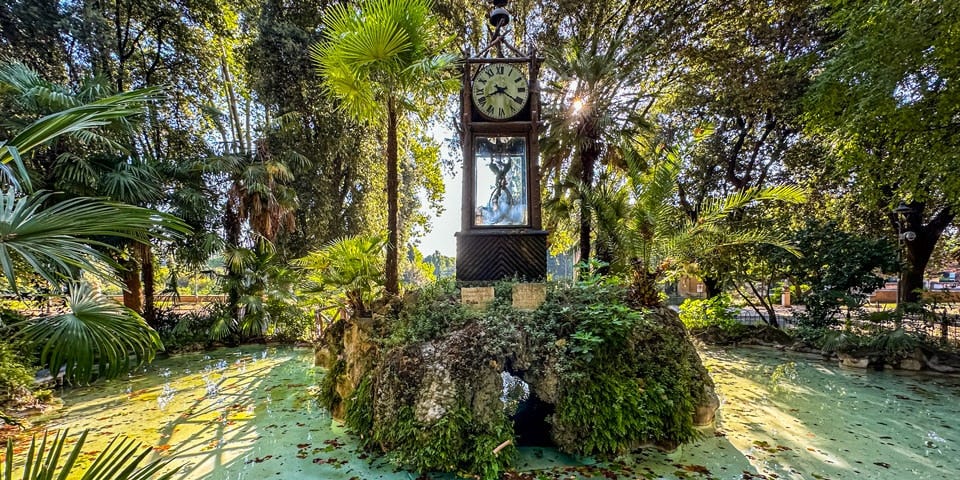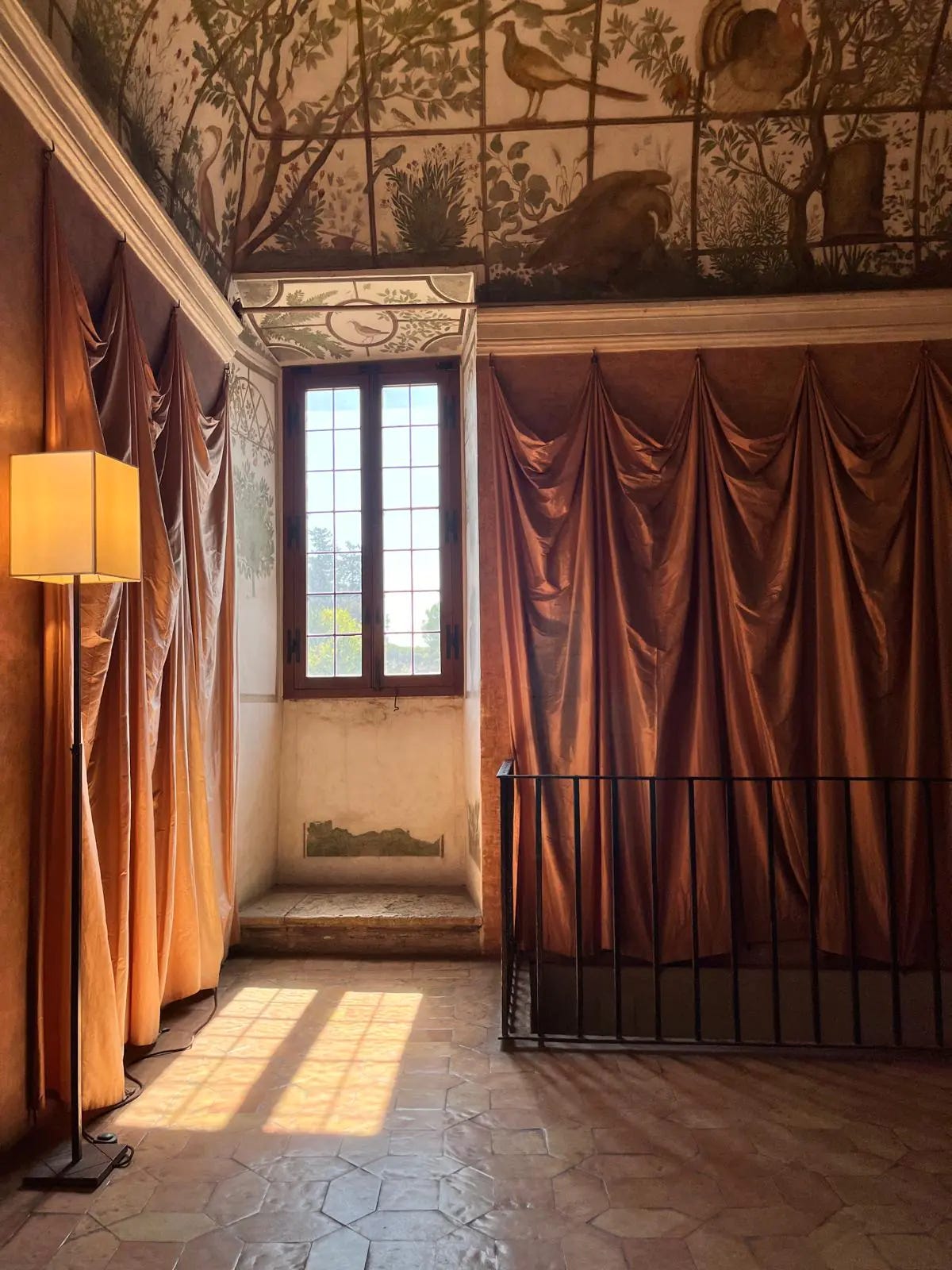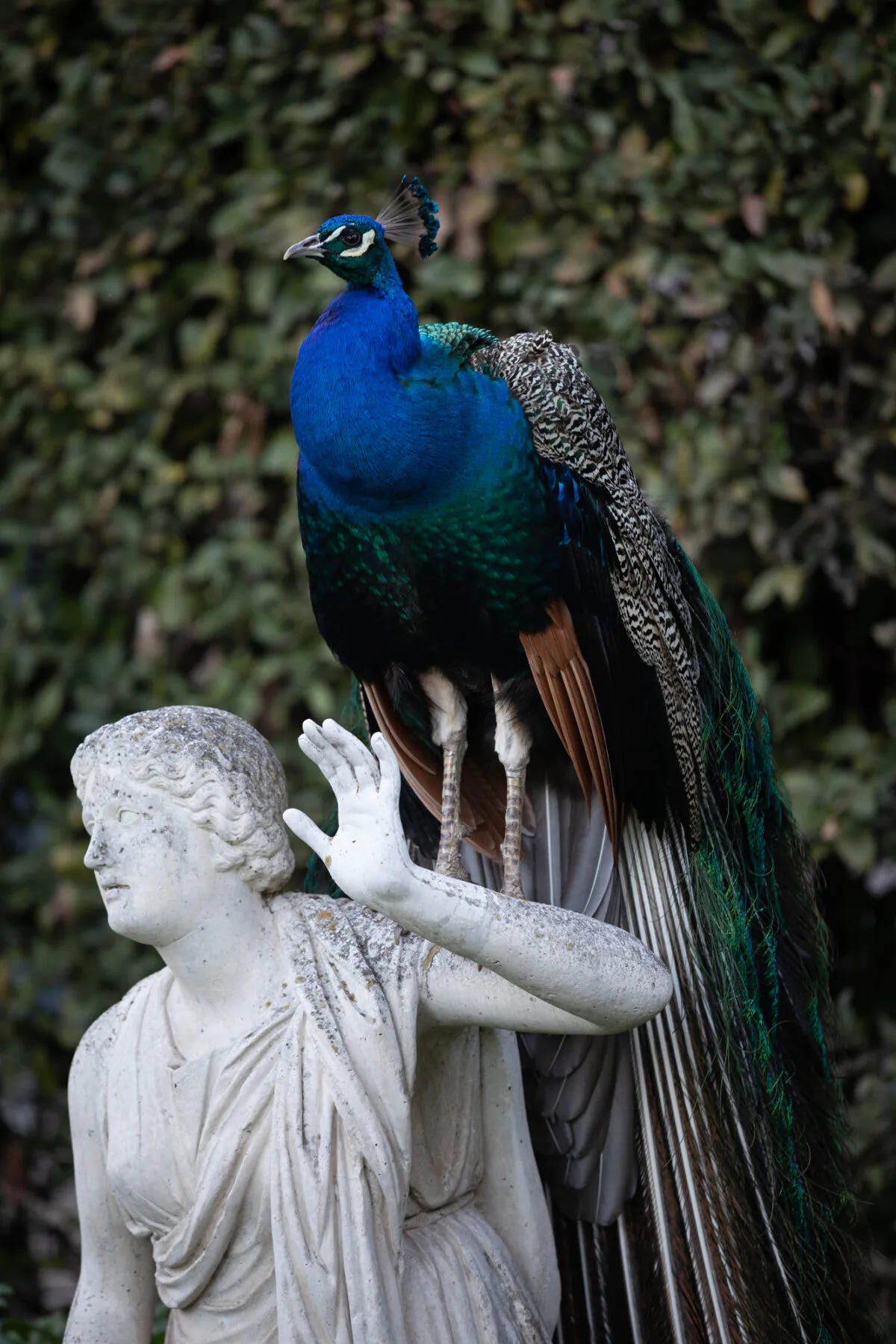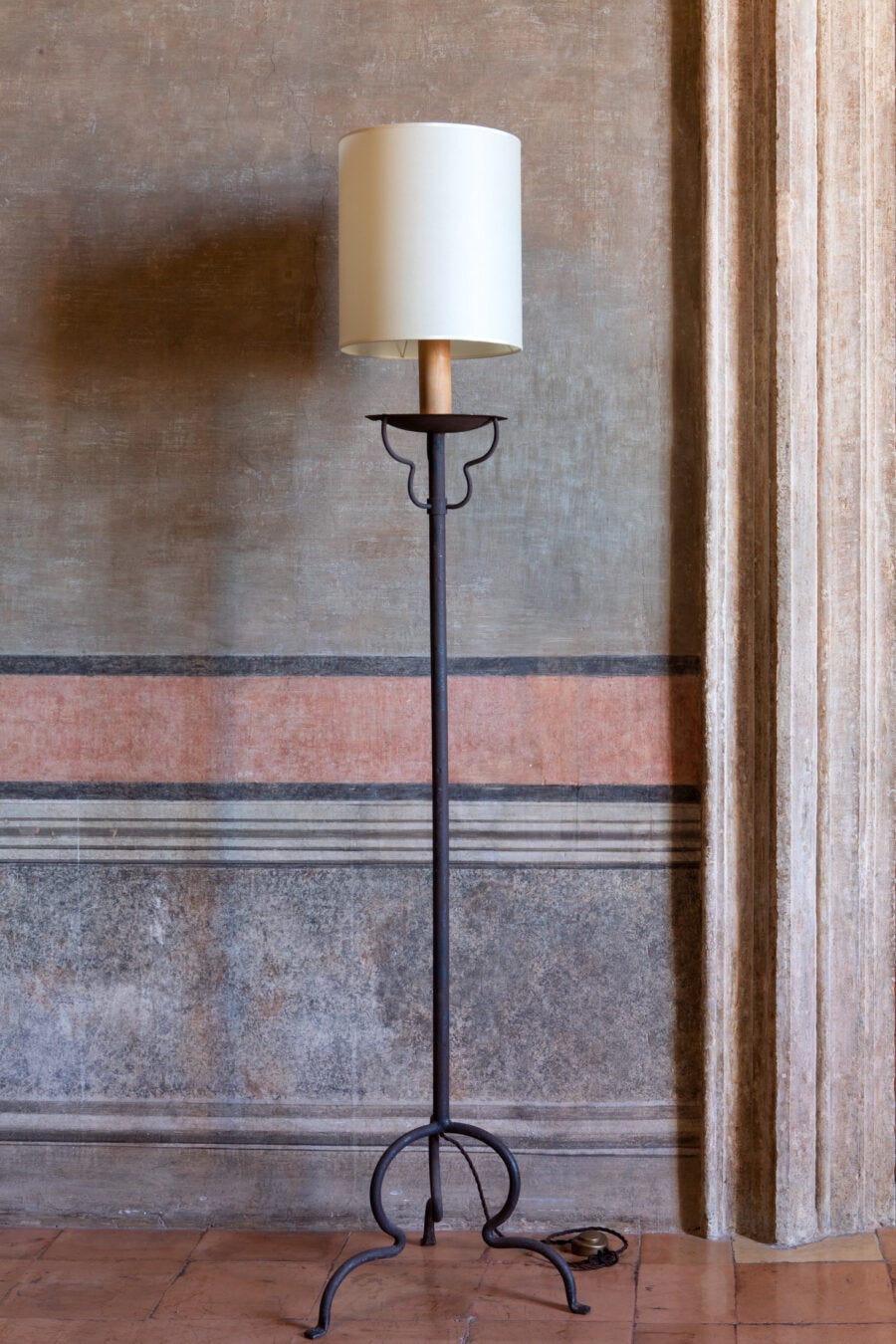Villa Medici will go down in my extensive annals of “beautiful places where I have been sick.” The day before my husband and I had planned to stay there, I came down with a throat situation and decided to go anyway; convalescing in a Renaissance palace seemed as good as convalescing anywhere else. Did its serenity heal me? No. Did I gain wistful satisfaction from hearing my cough reverberate through the empty halls at night? Oui.

When my husband told a Roman friend of his that we had been offered a two-night stay at the Medici because of a project I’m doing (now finished), the friend replied that he’d stayed there too—when he occupied the building with a group of student protestors in 2004, in reaction to French austerity laws. Occupying the Medici is much cooler than entering as a gracious guest, and next time I see a palazzo, I’ll consider breaking in instead of waiting to be invited.
But whether you’re there at the rejection or the behest of authority, the Medici authority, let’s say, feels rather granite when you’re inside one of their homes. On the other hand, when I was the Uffizi later gawking at portraits of the Medici kids I Googled “are there any living medicis” and was shocked to find that the official answer is “no,” or “extinct.” Plenty of wannabes but no one with a claim on the castle. If there is an investigative report I’ve missed, DM pls. (Or we can just wait for the 23andme data leak to bear fruit.)
The Villa, now in the center of Rome’s tourist zone atop the Spanish Steps, was built upon the ruins of various ancient Roman imperial estates, themselves built upon the ruins of an Etruscan temple that they’ve dug up parts of now and that looks like it was very special. By the sixteenth century, the Roman architecture had overgrown with grape vines. In the 1560s, a wealthy family constructed a country mansion there, and in 1576, Ferdinando de Medici—fifth son of Cosimo, Grand Duke of Tuscany, expert banker, and possibly the richest person in the world at the time—bought it and began to make it Dukeworthy.
Ferdinando had technically been a Cardinal since 13, but was never ordained, and liked to do other things instead, like collect antiquities, build sumptuous homes, and have legendary parties. He renovated the villa, adding wings, a tower, decorations, facades, and gardens—fresco-ing and plastering and sculpting and planting. The red granite fountain… the iconic marble lions… the turrets… the obelisk… and above all, the magnificent, otherworldly ceiling frescoes by Jacopo Zucchi—a virtuoso who covered all the rooms with birds, astrology signs, mythological figures, butterflies, and, in one room, people having sex in various positions. The “love” fresco room was deemed too debauched by a later Medici in the 1700s, who torched the ceiling.
When his older brother died in 1587, Ferdinando suddenly became the Grand Duke of Tuscany, which meant he needed to move to Florence stat to begin governing things and managing the family bank. (Lots to say about the Medici banking prowess; another time.) The fun and games and the enbeautification of the villa came to a rather abrupt halt, and he even took some of his favorite chunks of the villa with him when he left. It became a back-burner Medici property for the next century and a half, until the last Medici Male died in 1737 and it passed through other noble hands, until finally… Napoleon got it.
Rewind: as briefly described in my first post, Louis XIV founded the French Academy in Rome in 1666 so that he had somewhere to send French artists to copy and create faux antiquities so that he had enough objects to decorate Versailles. At that time, the French Academy was housed in a palazzo elsewhere in Rome. As you can imagine, arts funding for neoclassical reproduction petered out during the French Revolution, aka the revolutionaries abolished the academy for two years, and it took a while for the people who killed the partisans to get it up and running again.
Napoleon decided to really reboot the academy, and in 1803 he got his hands on the Villa Medici. Artists could once again win the Prix de Rome, get paid to go live in a gorgeous palace, and continue reproducing antiquity. But quickly artists stopped doing that and started doing more interesting things, as they are wont to do. Eventually many different types of artists showed up: musicians, printmakers, and even women. The list of prizewinners/residents over the next century is a roster of French illustriousness. Ingres, Fragonard, Boulanger, Debussy. A lot of them painted pictures of each other while they were there.
NOW THE PINTEREST BOARD
After another mid-century pause for a war to happen, in the 1960s a new era began at the French Academy in the villa. The painter Balthus (Balthasar Kłossowski de Rola), who is, yes, the artist known for making those creepy portraits of adolescent girls, became director, and launched a modernization scheme that is largely responsible for the what you see there today. The villa’s website has an excellent copy writer:
Under [Balthus’s] leadership, the Villa Medici and its gardens were radically transformed. With the help of restorers and scholars, Balthus unearthed the Renaissance frescoes and created wall decorations that cover almost the entire villa. Using an innovative technique, which brings out the material in successive layers, he managed to create a unique, vibrant and iridescent patina in each room. On the upper floors, his work blends harmoniously with the 16th-century friezes, which were rediscovered and restored. Today, this decoration is carefully preserved and restored.
Balthus’s vision was comprehensive: in addition to his paintings, he brought great variety to the decor. Contrary to palace traditions, he purchased antique furniture from all over Italy, which he did not hesitate to repaint, including church furnishings, cabinets and bookcases, and he began to create original lighting fixtures. On the cultural front, he pursued an ambitious exhibition policy, with retrospectives on such artists as Auguste Rodin, Gustave Courbet, Alberto Giacometti, and Georges Braque.
Balthus’s strategy for modernizing the villa included fake-re-aging it; on various walls you can still see test strips where he excavated layers of wall paint to find older colors, and then approximated them on the surface through what looks like a scratchy, hand-painted lime-wash. You end up with a muted off-kilter Pompeiian color scheme with strange texture somewhere between restoration and interpretation. At night, the walls look like they’re moving in and out of focus.
Perhaps you would like to approximate this effect and paint the walls of your home with fresco lime paint?


Every room has Balthus-designed lamps, which on screen look nice but in person are incredibly alluring and enchanting. The twisty, three-legged, rusted iron stand has a touch of dandy humor, and the light fixture at the top is a sneaky wood column that hints that a candle might be hiding inside the glowing lampshade. Art historian Jean Clair: the lamp “drew its inspiration from two ancient forms of light-fitting that were already in the palace: one; an old candelabrum in solid iron, the other a remarkably tall monumental nineteenth-century candlestick with a twisted base.” One must apply for a mortgage worth $3,128.00.
If you’re a prizewinner on a yearlong fellowship, you get to live in a little village adjacent to the gardens that was built in the 1950s, with a separate workspace in one of the special original studio buildings nestled in the garden itself. You eat lunch in a hall so unbelievably grand and pleasant that calling it a “cantina” feels silly.
If you’re an important visitor you can stay in one of the rooms at the very top of the tower, either the fantasy sultan chamber or one with preserved medieval frescoes and a pop-art bed:
If you’re a visitor like me, you get to stay in a newly built room that a hip European designer has constructed in the eastern wing; there are several still under construction. When I was there, peacocks were roaming over the construction site outside the building, pecking at the ground floor windows and trying to get in. I can’t show you what our room looked like because they ask you not to share pictures, but it was a strange wonder designed by architect Sébastien Kieffer with craft workshop Atelier Verneer; it featured a color-saturated kitchen unit and a bedroom loft that looks like a church pulpit dreamed up by Superstudio.
In 1971 Balthus also opened up the prize to art-adjacent fields, from restorers to art historians, and that’s how the fellowship still runs today under current director Sam Stourdzé. The exhibitions and curatorial projects there today are continually things that you (ok, I) genuinely want to see. They pick interesting people, they give them free reign to test things out, they’re hosting parties like masquerade balls in the gardens again—they aren’t papering over any of the history or legacy of the place, and they’re keeping it moving. I’m not saying Yay Nation State, just it’s nice when Nation Pays for Art or at least does not criminalize it. Not to say that student protestors shouldn’t be waiting in the wings, ready for just about anything anywhere these days.
FUNCTIONING 1867 WATER CLOCK
If you leave the Medici gates and walk over to the neighbors’ garden, which belongs to a nice family called the Borghese, you will find this steampunk hydrochrometer:

ONE OTHER THING FROM THE UFFIZI
Quick return to Florence. As mentioned in a previous post, Botticelli’s Primavera has at least 138 species of plants. The most common are daisies and violets. I’ve seen this and other Botticellis before but I hadn’t had the Big Experience of communion with him yet; probably because in Italian museums I run out of saliva after seeing Caravaggio; but this time I really fell for Springtime. The flowers float on the surface of the fabric and the grass, that scary blue guy swoops in from nowhere, the eerie-etherial-sexual symmetry satisfies a part of my lizard brain, and as my pal Theresia pointed out, the clothes look very Now.
IS THIS A LIFESTYLE BLOG?
No, this post is a Trojan Horse. Subscribe to find out what I’m smuggling inside the clickbait.














Still sad about that torched ceiling.
I have been made aware that Christopher Lee aka SARUMAN has Medici blood
https://x.com/MIB01010/status/1783122875857117507